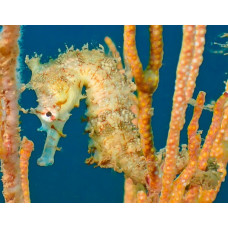Latin name
Hippocampus angustus
Other name
Narrow-bellied seahorse, western Australian seahorse.
Identification
The western spiny seahorse can be recognised by its slender body, long snout, well-developed spines and high crown.
Features of fish fins
Dorsal spines (total): 0; Dorsal soft rays (total): 17 - 19.
Fish colouring
The colouration is usually grey to brownish with white, yellow, orange or brown mottled patches on the head and body. There are 5-6 characteristic dark, irregularly shaped stripes on the muzzle.
Distribution
Widespread in the waters off Australia, from Perth to Hervey Bay, and in southern Papua New Guinea in the Torres Strait.
Habitat
It inhabits soft bottoms adjacent to coral reefs and on soft corals at depths from 3 to 63 meters (9.8-206.7 feet).
Size
Individuals of this species are usually about 16 centimetres (6.3 inches) long, but can reach up to 22 centimetres (8.7 inches).
Behavior
They live in sheltered bays and do not migrate.
Food and feeding habits
This species, like other seahorses, is thought to feed on small crustaceans.
Reproduction
It is oviparous, with males laying eggs in a brood pouch before giving birth to live young. This seahorse is monogamous when it comes to mating. During the mating season, males fertilise the eggs of only one female.
Fishing
The species is of minor commercial interest.
Relationship with a person
Harmless.
| Classification | |
| Phylum | Chordata |
| Class | Actinopterygii |
| Squad | Syngnathiformes |
| Family | Syngnathidae |
| Genus | Hippocampus |
| Species | H. angustus |
| Features | |
| Conservation status | Least Concern |
| Habitat | Bottom |
| Life span, years | No information |
| Maximum body weight, kg | No information |
| Maximum length, cm | 22 |
| Sailing speed, m/s | No information |
| Threat to people | Edible |
| Way of eating | Planktonophage |
Western spiny seahorse
Tags: western spiny seahorse

